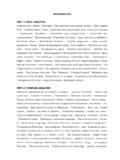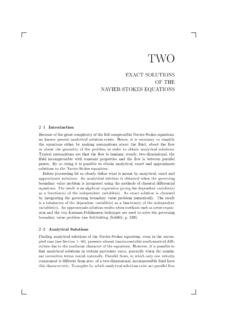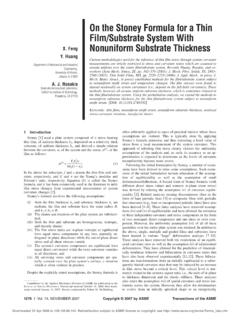Transcription of Unit 4: Mechanical Principles - FREE STUDY
1 1 Unit 4: Mechanical Principles Unit code: F/601/1450 QCF level: 5 Credit value: 15 OUTCOME 4 POWER TRANSMISSION TUTORIAL 1 SINGLE AND MULTILINK MECHANISMS 4. Dynamics of rotating systems Single and multi-link mechanisms: slider crank and three/four bar mechanisms; production of vector diagrams and determination of relationships between velocity, acceleration, power and efficiency Balancing: single plane and multi-plane rotating mass systems; Dalby s method for determination of out-of-balance forces and couples and the required balancing masses Flywheels: angular momentum; kinetic energy; coefficient of fluctuation of speed; coefficient of fluctuation of energy.
2 Calculation of flywheel mass/dimensions to give required operating conditions Effects of coupling: conservation of angular momentum; energy loss due to coupling; final common rotational speed It is hard to believe that the designers of this module have added this section to the previous syllabus as it is a major topic. Students will do well to cover this tutorial alone in the allotted STUDY time. Calculation of the power input to a mechanism to overcome the inertia of the moving parts would require another equally large tutorial and it is only briefly covered. On completion of this short tutorial you should be able to do the following.
3 Describe a mechanism. Define relative and absolute velocity. Define relative and absolute acceleration. Define radial and tangential velocity. Define radial and tangential acceleration. Describe a four bar chain. Solve the velocity and acceleration of points within a mechanism. Use mathematical and graphical methods. Construct velocity and acceleration diagrams. Calculate the inertia force due to acceleration. It is assumed that the student is already familiar with the following concepts. Vector diagrams. Simple harmonic motion. Angular and linear motion. 2 Inertia force. Appropriate level of mathematics.
4 All these above may be found in the pre-requisite tutorials. 3 1. MECHANISMS A mechanism is used to produce Mechanical transformations in a machine. This transformation could be any of the following. It may convert one speed to another speed. It may convert one force to another force. It may convert one torque to another torque. It may convert force into torque. It may convert one angular motion to another angular motion. It may convert angular motion into linear motion. It may convert linear motion into angular motion. A good place to start is with the mechanism called the Scotch Yoke which converts a constant rotation into a perfectly sinusoidal motion known as Simple Harmonic Motion.
5 SCOTCH YOKE The wheel revolves at radians/sec and the pin forces the yoke to move up and down. The pin p slides in the slot and the yoke oscillates up and down in the vertical direction only. The motion of point p is simple harmonic motion. The rotation is measured from the horizontal position so the angle rotated in time t is t radian. At any moment it has a displacement x, velocity v and an acceleration a. The pin is located at radius R from the centre of the wheel. By simple trigonometry x = R sin( t). Velocity is the rate of change of distance with time and in calculus form v = dx/dt.
6 If we differentiate x we get v = dx/dt = R cos( t). Acceleration is the rate of change of velocity with time and in calculus form a = dv/dt. Differentiating v we get a = dv/dt = - 2R sin( t). The plot of x, v and a against angle is shown. All are perfectly sinusoidal graph but each is displaced 90o 4 PISTON, CONNECTING ROD AND CRANK This is the mechanism found in engines and pumps and other many other machines. If the crank is turned, angular motion is converted into linear motion of the piston and input torque is transformed into force on the piston.
7 If the piston is forced to move, the linear motion is converted into rotary motion and the force into torque. If the crank rotates at constant speed rad/s the motion of the piston is not perfectly harmonic. This is shown by the following example that uses the same Principles as before but the maths is harder. WORKED EXAMPLE Derive mathematical equations relating displacement, velocity and acceleration to crank angle for the mechanism illustrated. Plot the graphs and comment on their shape. Determine the maximum acceleration of the piston when the crank speed is 30 rev/min clockwise.
8 Show that if the crank radius is reduced to 10 mm that the motion becomes almost harmonic. SOLUTION When = 0 the piston will be furthest left at a distance of 170 mm from point O. Take this as the reference point and measure displacement x from there. Remember that = t and = 2 x 30/60 = rad/s. The displacement is then 22 t50sin120 t50cos170x Differentiate to get the velocity tcos t sin tsin2500144002500 t50 0 sv2 Differentiate again to get the acceleration. 2222322 tcos tsin t2500sin144006250000 tcos50 a + .. 222222 tsin t2500sin144002500 tcos t2500sin144002500 5 The diagram shows a plot of displacement, velocity and acceleration against angle.
9 It should be noted that none of them are sinusoidal and not harmonic (in particular, the acceleration). The units are all in mm and seconds. The above was done with a computer package. Plotting the above functions over a complete rotation shows that the maximum acceleration occurs at t = 0 ( = 0) and evaluating gives an answer of 700 mm/s2. If the radius of the crank is small in comparison to the length of the connecting rod, the motion becomes close to sinusoidal. To illustrate this, here is the plot with the crank radius reduced to 10 mm. The acceleration is now almost sinusoidal. The main point is that the motion produced is anything but simple harmonic motion and at any time the various parts of the mechanism have a displacement, velocity and acceleration.
10 The acceleration gives rise to inertia forces and this puts stress on the parts in addition to the stress produced by the transmission of power. For example the acceleration of a piston in an internal combustion engine can be enormous and the connecting rod is subjected to high stresses as a result of the inertia as well as due to the power transmission. Clearly using this method of analysis is mathematically difficult and unless you have access to a computer package to solve it, we need a graphical method. 6 FOUR BAR CHAINS You will find in these studies that the various parts are referred to as links and it can be shown that all mechanisms are made up of a series of four links.


















